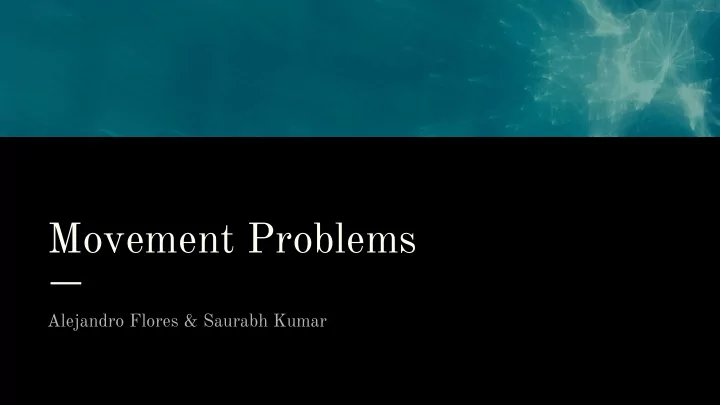

Movement Problems Alejandro Flores & Saurabh Kumar
Movement Problems
Introduction to Movement Problems Introduced by [DHMSOZ ’07, ’09] ● Given a graph G and some initial positions of pebbles, move the pebbles to ● achieve some property P so as to minimize: ○ The total distance covered (SUM) ○ The maximum distance traveled (MAX) ○ The number of pebbles moved (NUM) Can be extended to a computational geometric setting where we replace graphs ● with euclidean planes [AFGKS ’11].
Some movement problems Controlling Mobile Network Sensors: Connectivity, Path , Limited Signal Range. ● Freeze Tag [ABFMS ’02]: Wake up robots recursively. ● Move robots in the presence of obstacles [TPKI ’10]. ● Barrier Coverage [CKKLNOSUY ’10]: Make sure signals cover a boundary. ● Game AI: Moving game agents to certain configurations optimally. ● Warfare: Move military units to flank enemy. ● Mobile Facility Location Problem [FS ’11]: Moving both clients and facilities. ●
Given a graph with some initial configuration of pebbles, move them PathMax so as to connect s and t and minimize the maximum movement. O(1+ √ m /OPT) approximation Proof from [DHMSOZ ’09]
1. Mark vertices that can be in OPT v cannot be in OPT if: Ǝ i ≤ min(d sv , d vt ) and there are less O P than 2 i + 1 pebbles T v within distance i + OPT of v i Maximum Movement = 0 OPT +i
2. Move Pebbles to Nearest Marked Vertex Delete all pebbles for whom the distance to nearest marked vertex > OPT Maximum movement = OPT
3. Find Shortest Path + Centers Find marked least cost path P = {s = v 0 , v 1 , v 2 , … , v |P| = t} Center Vertices = { v k , v 3k+1 , v 5k+2 , … } For each center, move all pebbles within radius k to that center Then spread them out to the M empty vertices Maximum movement = OPT+2k
2 k + 1 k k P Amount of pebbles at at most k - OPT distance from center c is at least 2(k-2OPT)+1 Move pebbles to the nearest center and spread them through P. For each center we have at most 4OPT nodes without pebbles...
Good and Bad Pebbles Good - pebble on P and part of OPT P Bad - pebble not on P but part of OPT We have at least M bad pebbles Max Movement for Bad Pebbles += OPT k
movement to centers + spread 2 k + 4OPT + H(P b , P g ) marked vertex 2 k + OPT initial OPT position P g initial P b position OPT target positions in OPT OPT Optimal Path H(P b , P g ) Bound on Distance between Good and Bad Pebbles
4. Move Bad Pebbles Move bad pebble P b to nearest good pebble in final configuration P g Shift all pebbles from P g one forward till we fill up an empty vertex P g P b P
5. Careful Counting Maximum movement = OPT + max{2 k , 2 k + 4OPT + M} + M ⇒ Maximum movement = 6k + (5 + 4 m / k )OPT Set k = √ m OPT Result follows
Thanks!
References 1. [DHMSOZ ’09] Demaine, Erik D., et al. "Minimizing movement." ACM Transactions on Algorithms (TALG) 5.3 (2009): 30. 2. [AFGKS ’11] Fazli, MohammadAmin, et al. "Euclidean Movement Minimization." CCCG. 2011. 3. [FS ’11] Friggstad, Z., & Salavatipour, M. R. (2011). Minimizing movement in mobile facility location problems. ACM Transactions on Algorithms (TALG), 7 (3), 28. 4. [ABFMS ’02] Arkin, Esther M., et al. "The freeze-tag problem: how to wake up a swarm of robots." Algorithmica 46.2 (2006): 193-221.
References 5. [CKKLNOSUY ’10]Czyzowicz, Jurek, et al. "On minimizing the sum of sensor movements for barrier coverage of a line segment." Ad-Hoc, Mobile and Wireless Networks. Springer Berlin Heidelberg, 2010. 29-42. 6. [TPKI ’10] Tekdas, Onur, et al. "Maintaining connectivity in environments with obstacles." Robotics and Automation (ICRA), 2010 IEEE International Conference on. IEEE, 2010.
Recommend
More recommend